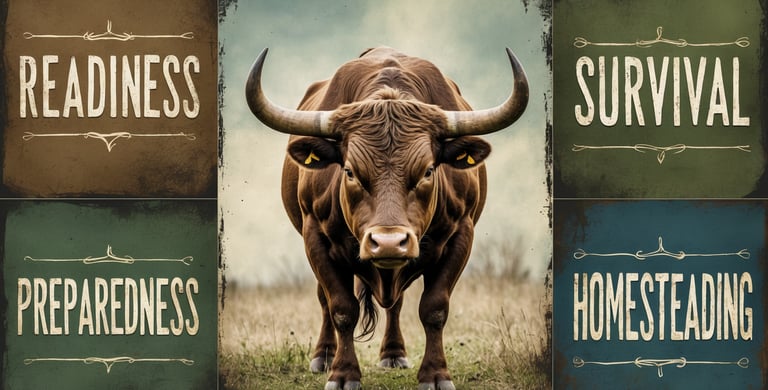Readiness: Physical Conditioning for Crisis
Training the Body for the Day That Comes
4FORTITUDER - READINESS, SURVIVAL, PREPAREDNESS, HOMESTEADING
Readiness: Physical Conditioning for Crisis
Training the Body for the Day That Comes
"The more you sweat in peace, the less you bleed in war."
— Sun Tzu
When the Sirens Wail, Strength Must Answer
In crisis, your body is your first and last tool. If it fails—you fail. No plan survives contact with the enemy, and no survival strategy matters if the body is weak, brittle, or untrained. Readiness is not theoretical. It is physical. It is how fast you move, how long you endure, and how hard you hit when the moment calls for action.
Laozi said, "He who controls others may be powerful, but he who has mastered himself is mightier still." The man who trains his body with sacred discipline prepares not only for battle—but for burden. He can carry the wounded. He can climb when roads fail. He can fight when the law is far away. He endures, not by accident, but by design.
Core Knowledge Foundation: Principles of Tactical Conditioning
Physical conditioning for readiness is not the same as aesthetic fitness. It does not chase symmetry or stage presence—it builds capacity: to lift, to run, to grapple, to carry, to function under duress. It integrates strength, endurance, mobility, and resilience.
Core components:
Functional Strength: Compound movements—deadlifts, squats, presses, carries. Train muscles to work together.
Cardiovascular Endurance: Rucking, sprint intervals, mixed-modal endurance (burpees, sled work, assault bike).
Mobility and Joint Integrity: Loaded stretching, dynamic warmups, active recovery protocols.
Stress Response Conditioning: Training under duress—timed circuits, breath holds, cold exposure.
Misconception Warning: Tactical conditioning is not about volume. It is about intensity, recovery, and transferability to real-world movement demands.
Advanced Insights: Training the Warrior-System, Not the Gym Body
A crisis doesn't care what you bench. It asks what you can do. Can you sprint 400 meters in boots with 40 lbs of gear? Can you drag your unconscious brother across gravel? Can you climb a wall when adrenaline floods your system?
Historical Anchor: Spartan Agoge Training
The Spartans didn’t train to look strong. They trained to survive. To fight. To protect. Young men in the Agoge carried logs, wrestled blindfolded, and ran for miles barefoot. They knew the battle would not reward cosmetic fitness—it would expose it.
Modern equivalents must mirror this mindset:
Farm Boy Conditioning: Sandbags, sleds, logs—odd objects that build real-world capacity.
Mental-Physical Integration: Every session includes breath control, task prioritization, and fatigue resistance.
Your gym is not a sanctuary. It is a forge.
Practical Drill: Every week, complete one “SHTF Scenario Circuit”:
Sprint 100 yards
Carry 100 lbs 50 yards
Drag 150 lbs 30 yards
Vault, climb, or crawl an obstacle
Finish with breath control: 3-minute box breathing under load
Record performance. Improve under pressure.
Critical Perspectives: The Deceptive Lie of Specialization
Adversarial Viewpoint: "Why train like a soldier if you're not one? Life isn't a warzone. General fitness, stress management, and walking are enough for longevity."
Response: Longevity without capacity is a fragile peace. The man who trains only for ease will not survive hardship. Crisis doesn't ask for gym credentials. It demands action, violence, and stamina. Your body is either an asset—or an obstacle.
Wisdom and Warning Duality:
When Followed: Your body becomes a weapon and a refuge. It enables leadership under chaos and preserves life when seconds matter.
When Ignored: Injury, collapse, paralysis. You become the liability your family must carry—because you chose comfort over preparation.
Strategic Crossroad: Will you train like comfort is permanent—or like duty is coming?
Final Charge & Implementation
Brother, strength is not optional. It is not aesthetic. It is obligation. Train for the weight of responsibility—not the applause of the world.
Begin now:
Adopt a Tactical Training Cycle
"He who trains for aesthetics may impress—but he who trains for war will survive." — Logan Hanks, Tactical Strength Coach
Plan 3-day, 5-day, or 6-day cycles integrating strength, endurance, mobility, and load-bearing.Monthly Capacity Test
"Preparedness without measurement is fantasy." — Pavel Tsatsouline (paraphrased)
Once per month: test your 1-mile run, 100-yard carry, max pushups in 2 minutes, and weighted pull-ups. Record and adjust training.
Strategic Reflection:
What physical task, if required today, would reveal your unreadiness? Are you okay with that?
Existential Challenge:
When the time comes, will your body answer the call—or collapse under the weight of what you refused to prepare for?
Train your flesh to serve your mission. Build muscle that endures. Harden joints that move. Breathe through fire—and keep walking.
"In crisis, your gear is secondary. Your plans are secondary. Your body—is primary."


